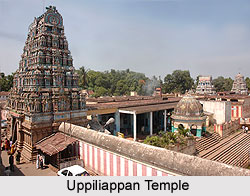 The Uppiliappan Temple is a famous temple dedicated to Lord Uppiliappan Perumal, his consort Bhumi Devi and her father sage Markandeya. It is located in the Thanjavur district of Tamil Nadu. The temple is regarded as one of the 108 Divya Desams. The temple is associated with a legend. According to it once, Tulsi Devi requested Lord Vishnu to give her a place on his chest like Goddess Lakshmi. They Lord told her that Lakshmi did very severe penance to gain a place on His chest. He also told her that Lakshmi would appear as Bhoomidevi at a holy place near Kumbakonam, to the south of Kaveri as the daughter of sage Markandeya. He instructed Tulsi to go there earlier and be in the form of lovely Tulsi plant at the sage`s hermitage. Then Lakshmi would appear under the Tulsi plant as Bhoomidevi. Later on the Lord would come and marry Bhoomidevi and live there forever. Then the glory of Tulsi will become known to all. Vishnu said that anyone who would worship him with Tulsi shall be blessed. Thus, fromn then Tulsi lived in that holy place, which therefore came to be known as Tulsi Vana or Tulsi forest.
The Uppiliappan Temple is a famous temple dedicated to Lord Uppiliappan Perumal, his consort Bhumi Devi and her father sage Markandeya. It is located in the Thanjavur district of Tamil Nadu. The temple is regarded as one of the 108 Divya Desams. The temple is associated with a legend. According to it once, Tulsi Devi requested Lord Vishnu to give her a place on his chest like Goddess Lakshmi. They Lord told her that Lakshmi did very severe penance to gain a place on His chest. He also told her that Lakshmi would appear as Bhoomidevi at a holy place near Kumbakonam, to the south of Kaveri as the daughter of sage Markandeya. He instructed Tulsi to go there earlier and be in the form of lovely Tulsi plant at the sage`s hermitage. Then Lakshmi would appear under the Tulsi plant as Bhoomidevi. Later on the Lord would come and marry Bhoomidevi and live there forever. Then the glory of Tulsi will become known to all. Vishnu said that anyone who would worship him with Tulsi shall be blessed. Thus, fromn then Tulsi lived in that holy place, which therefore came to be known as Tulsi Vana or Tulsi forest.
According to another legend Sage Mrikandu`s son Markandeya, travelled many holy places and finally settled in Uppiliappan. He began worshipping the Lord with great devotion in order to be blessed with a daughter who would be given in marriage to Lord Narayana himself. Lord Narayana was pleased by his penance. He asked Lakshmi to appear as a small child to the sage in the Tulsi forest. She was to be brought up by sage Markandeya and later given in marriage to the Lord. The sage being blessed with the child brought her up lovingly. As she grew up, he was very much worried about her marriage. He began searching for a suitable bridegroom. Lord Narayana thought of playing some mischief with the sage. He appeared before the sage, in the guise of an old Brahmin. Markandeya, without could not recognise the Lord but welcomed the Brahmin due reverence. He asked the Brahmin the purpose of his visit. The later told him that he wished to marry and settle down and beget good sons and for this reason he sought the hand of Bhoomidevi. The sage then explained that his daughter was too young to run a family and the age disparity between the old man and the young girl was too much. The Brahmin refused to listen and threatened to commit suicide if his demands were not fulfilled. The sage then began praying to Lord Narayana for guidance. Finally his prayers were answered. The sage when opened his eyes saw Lord Narayana in all splendour and glory in place of the Brahmin. He then realised that the Lord had played a prank on him cried out of ecstasy. The Lord said that he would marry his daughter Bhoomidevi and will take only saltless offerings in this temple. The sage then asked for three boons that the Lord, after marrying Bhoomidevi, should stay in this place forever, the holy place should be known in his name as Markandeya Kshetra and the salt less offerings in this temple should also be relished by the devotees. The Lord gladly granted the boons as prayed for and further blessed that the place will be known as "Tiruvinnagar" and "Tulsivana Markandeya kshetra."
The Lord Himself wrote out the marriage invitation and instructed His vehicle Garuda to hand over the invitations to Lord Brahma and all devas. The marriage was conducted on the day of sravanam in the month of Aippasi. All devas attended the divine marriage. The holy wedding of the Lord and Bhoomidevi was duly conducted on a grand scale according to Vaikhanasa Agamas. Then onwards, the Lord continues to reside in this temple, along with His consort Bhoomidevi.





















